THE MOVEMENT OF PERSONNEL Contents 4.1. Career Management


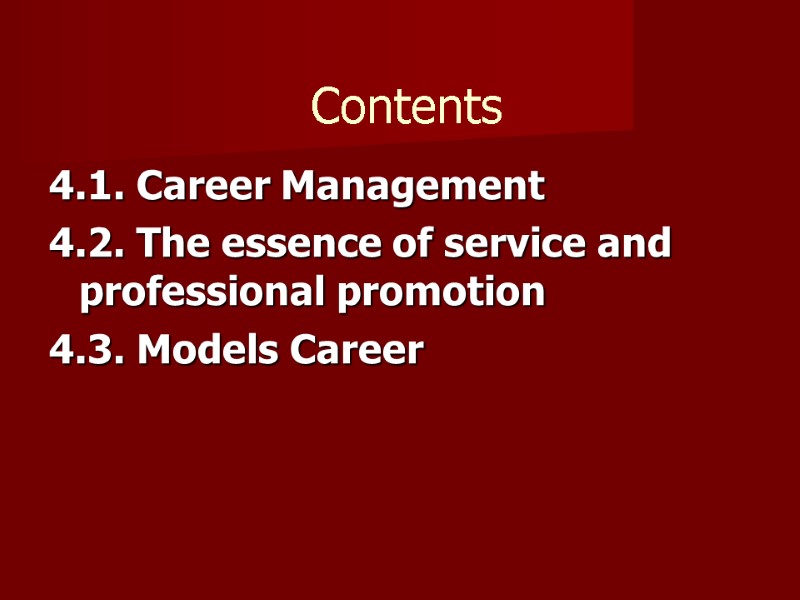
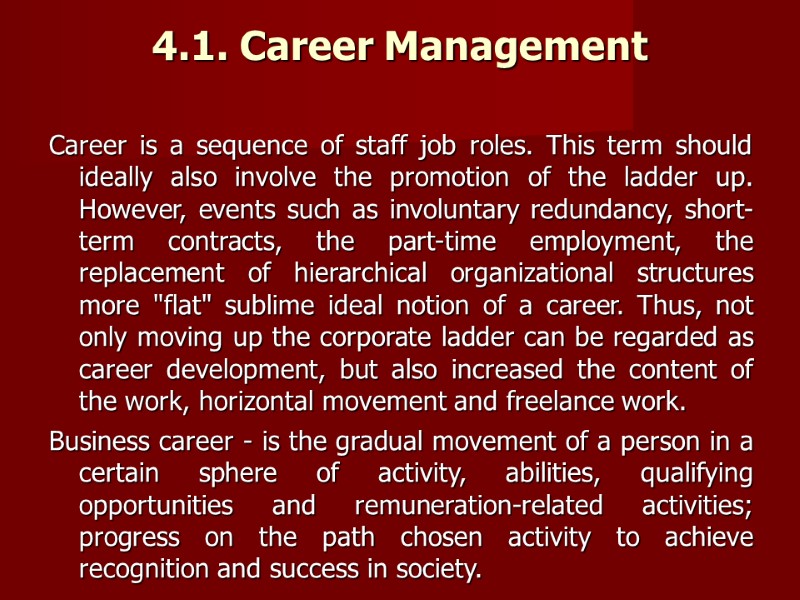
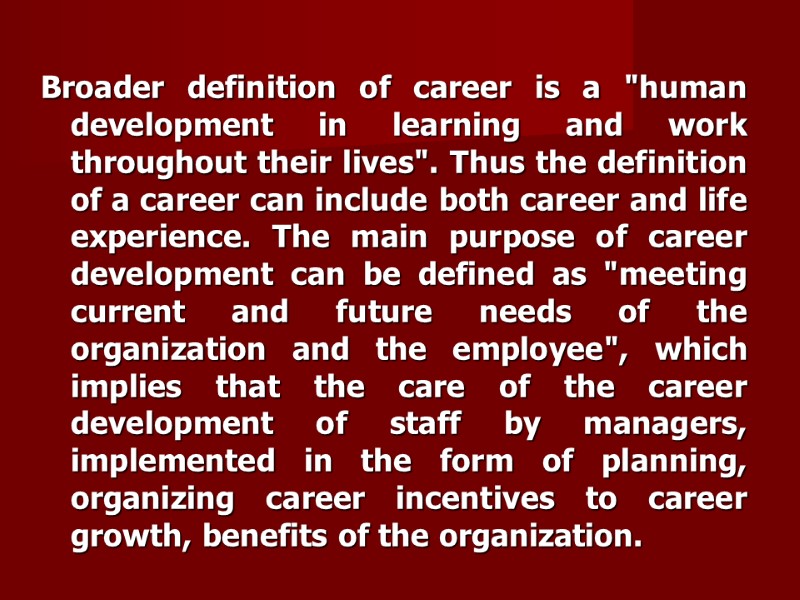
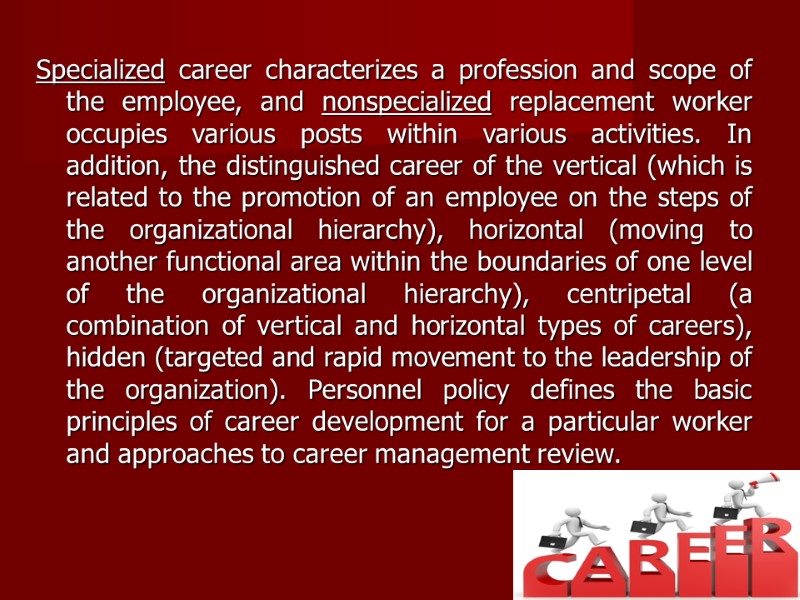
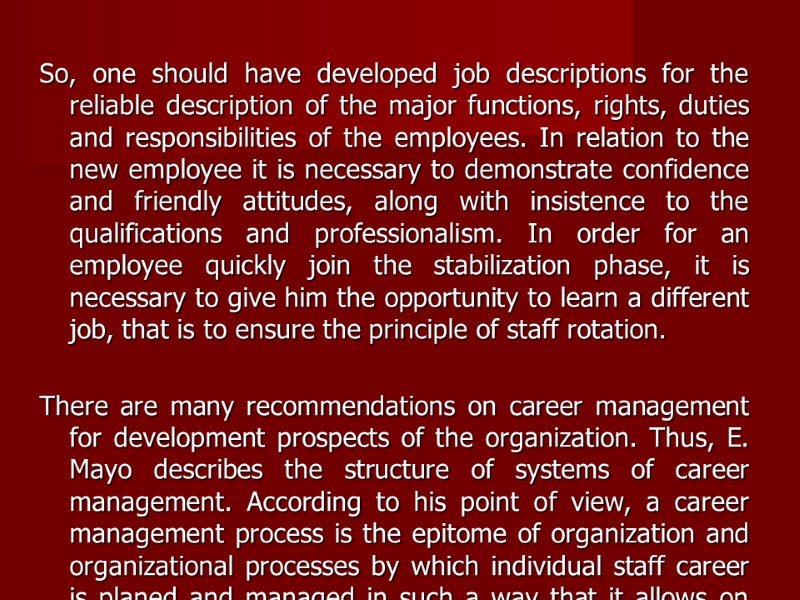
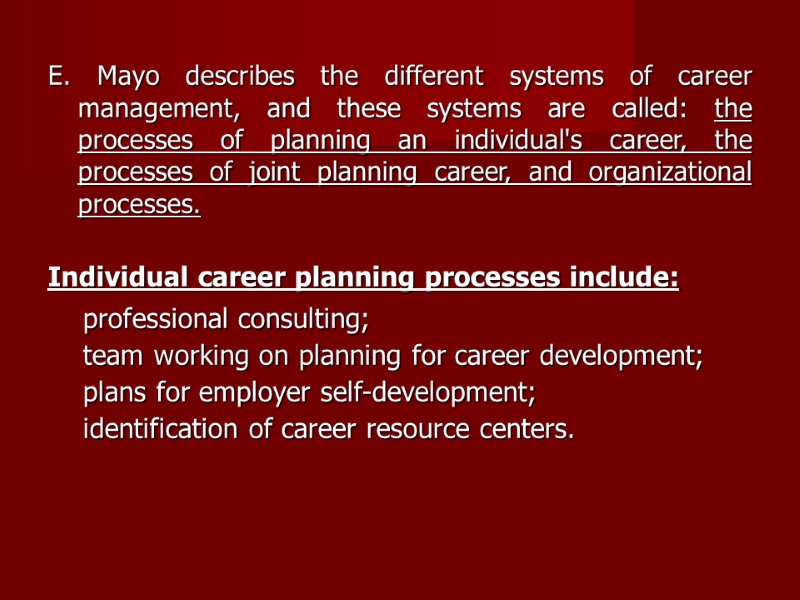
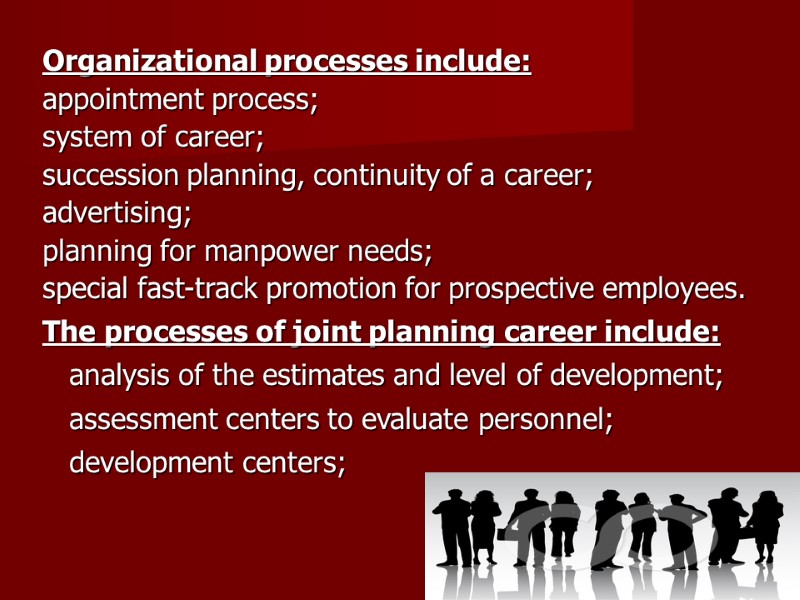
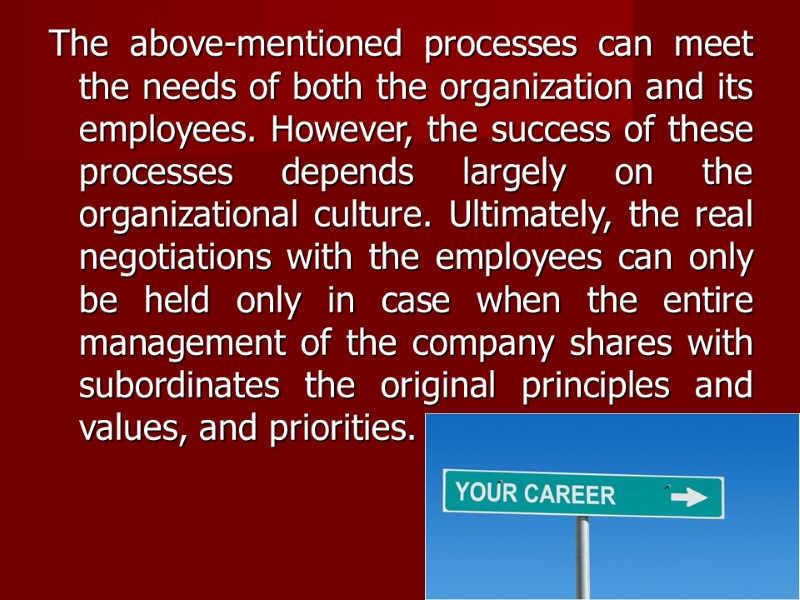
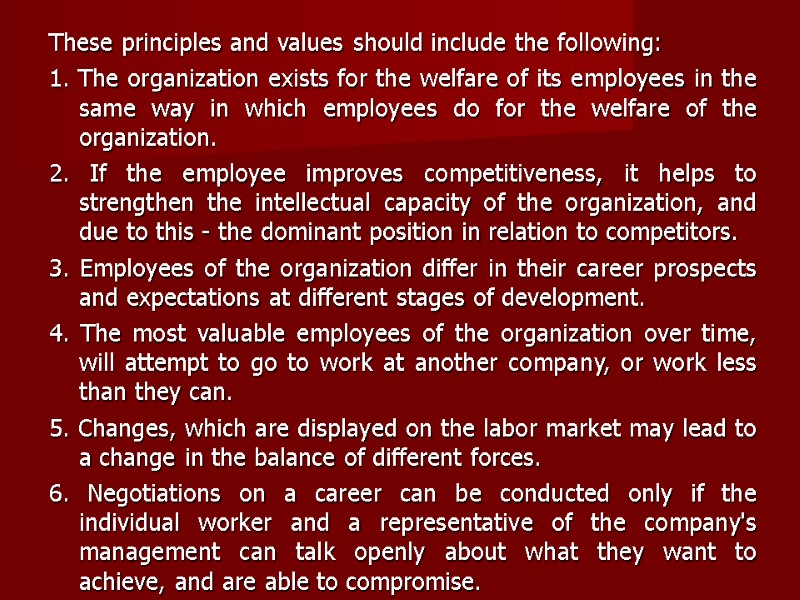
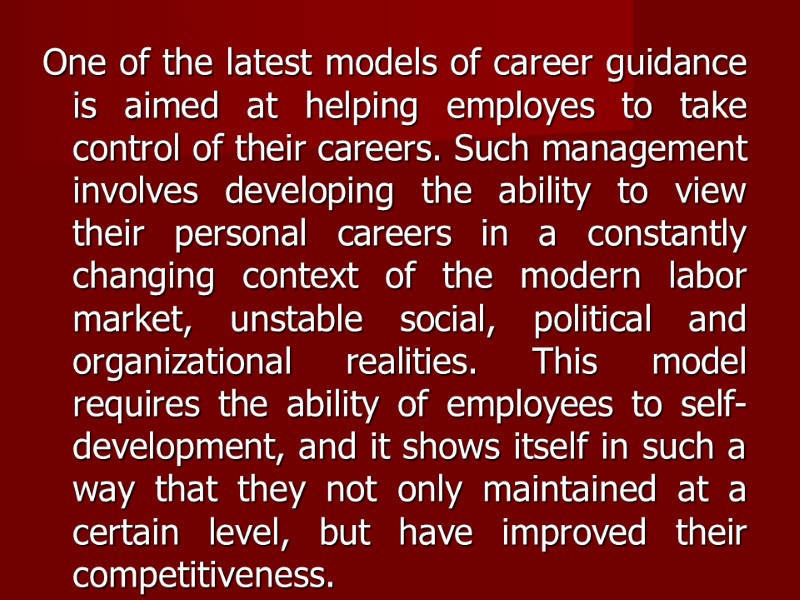
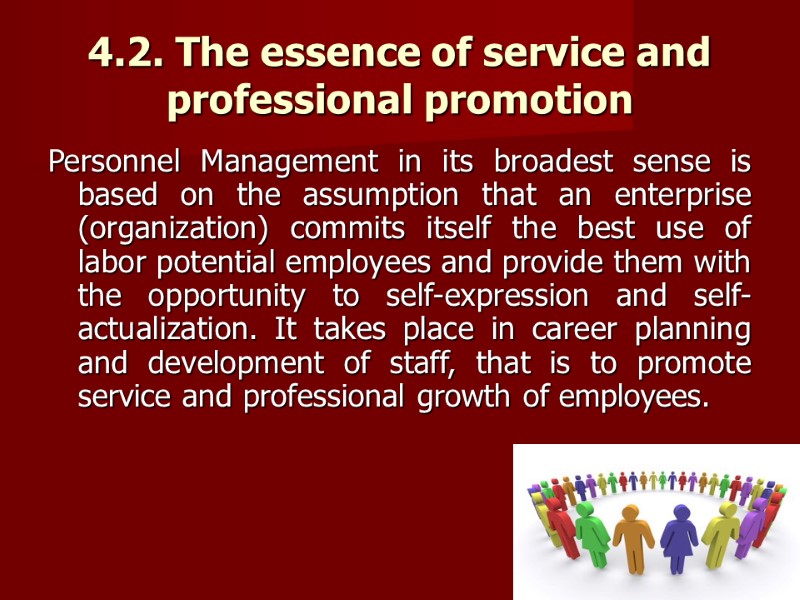
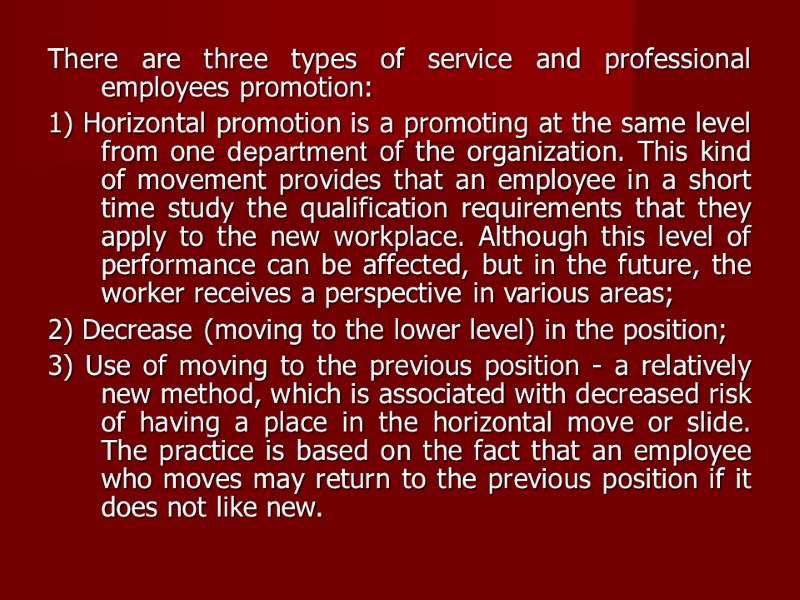
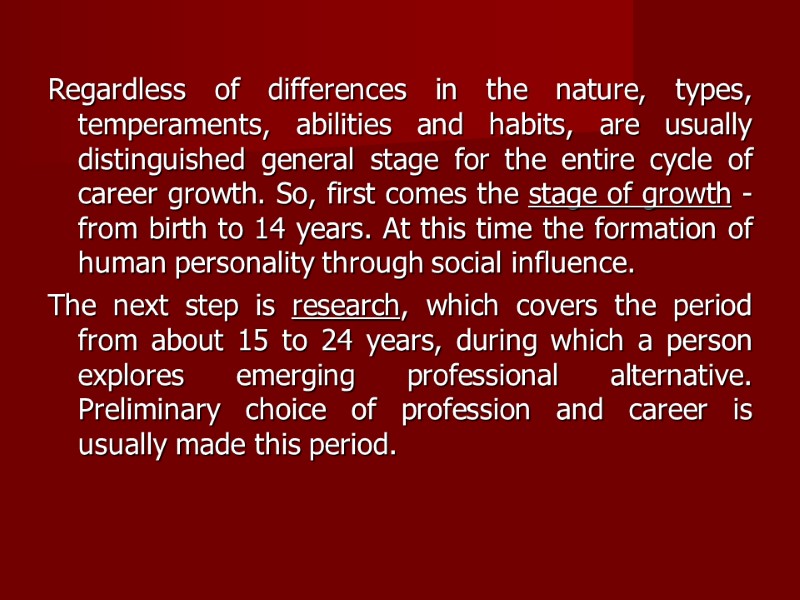
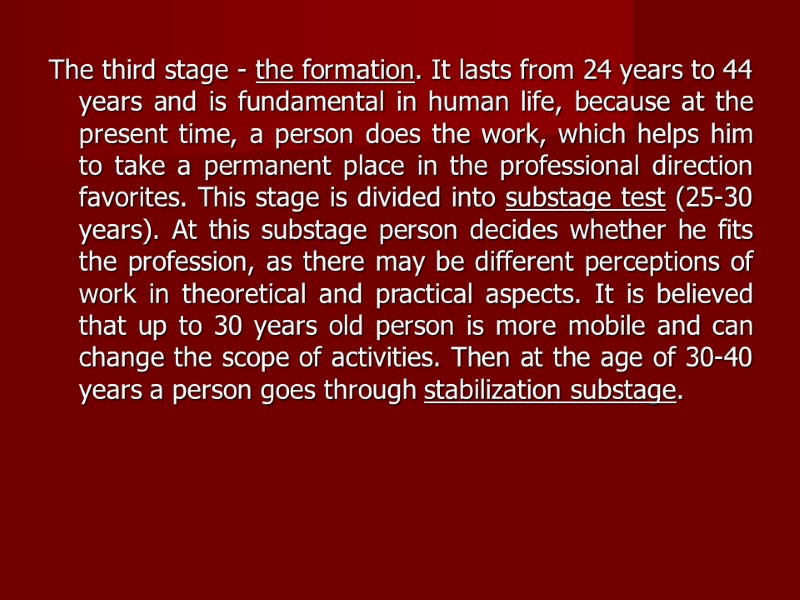
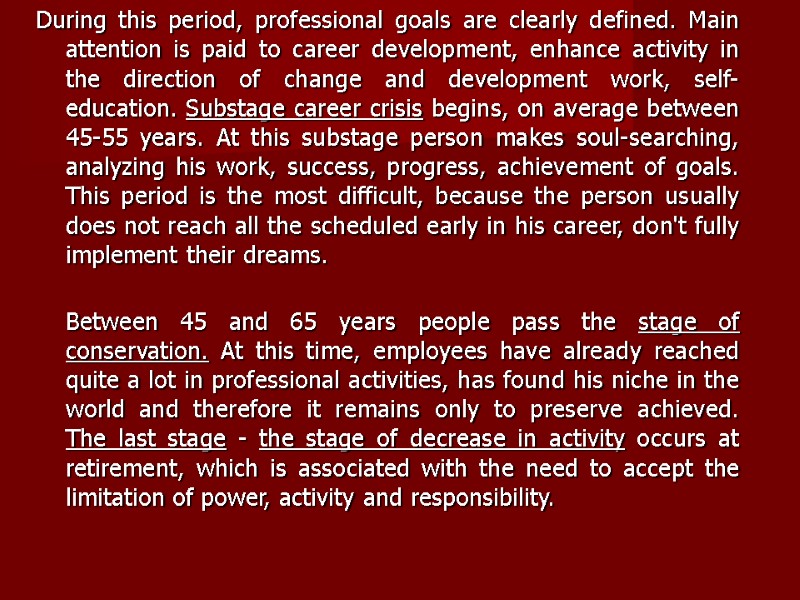
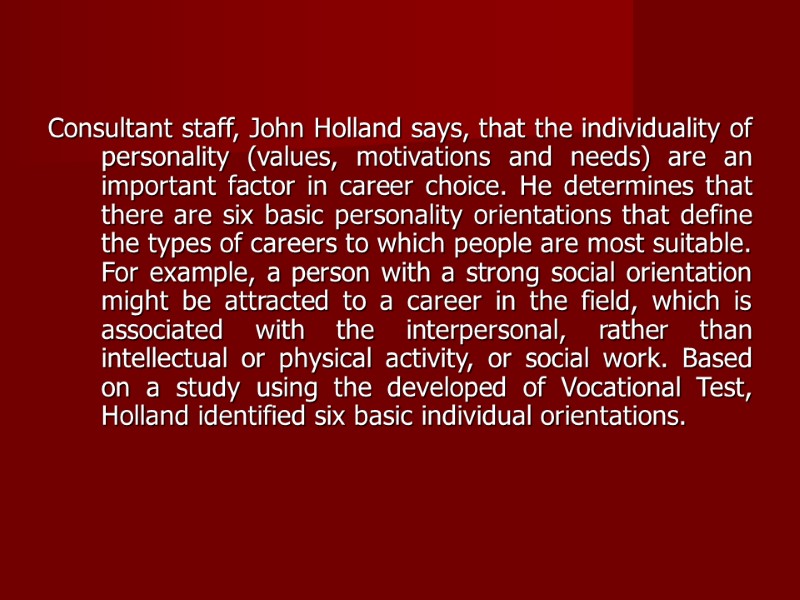
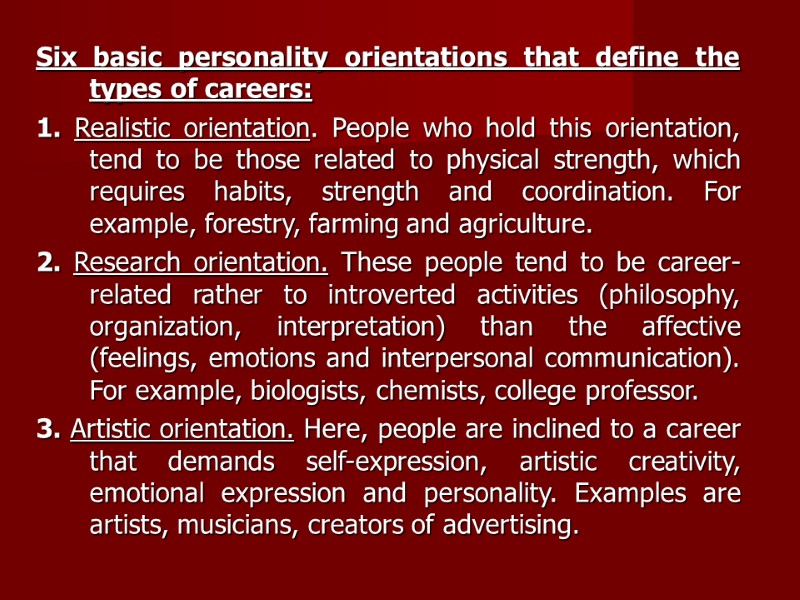
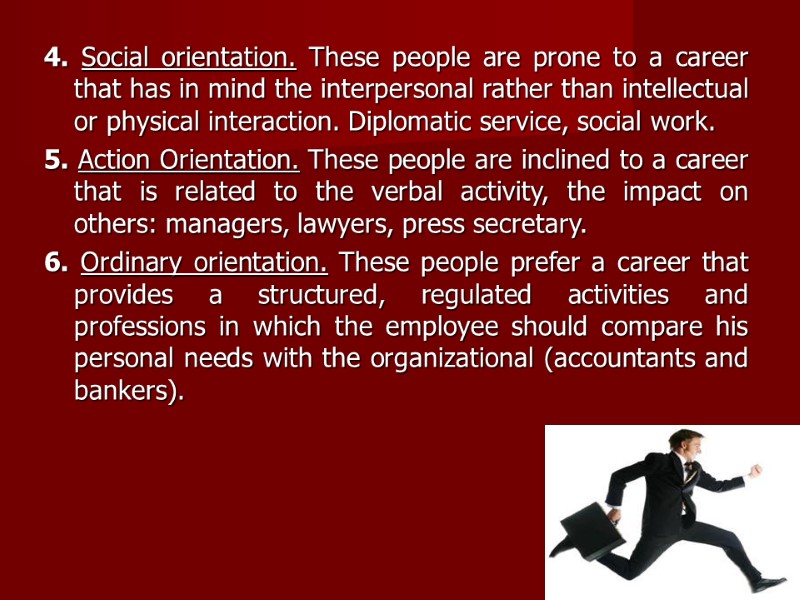
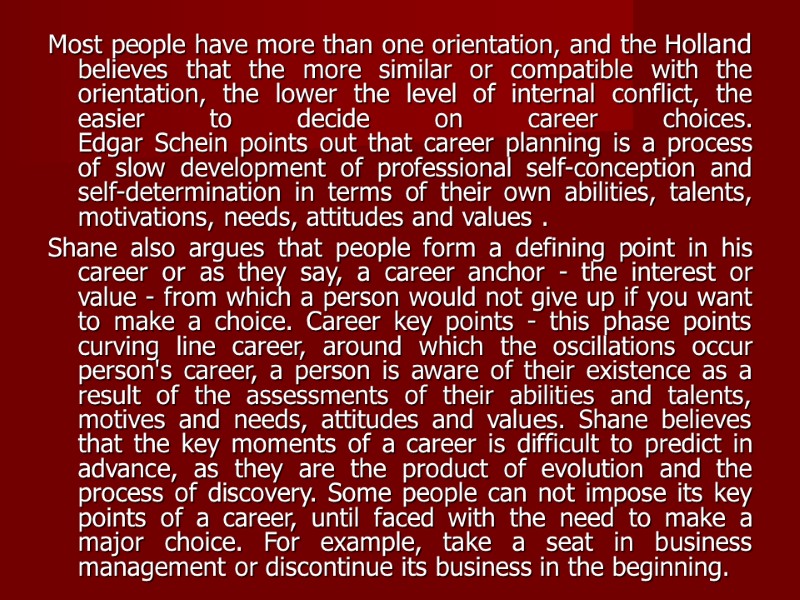
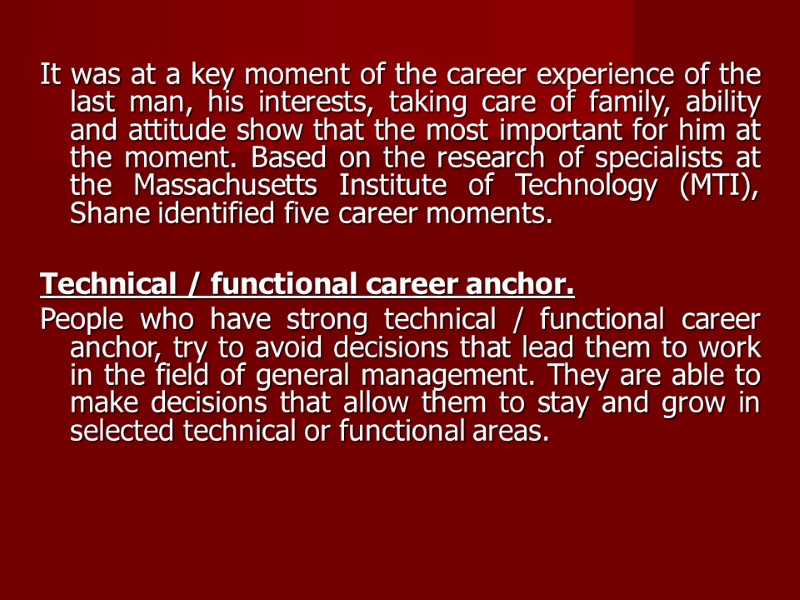
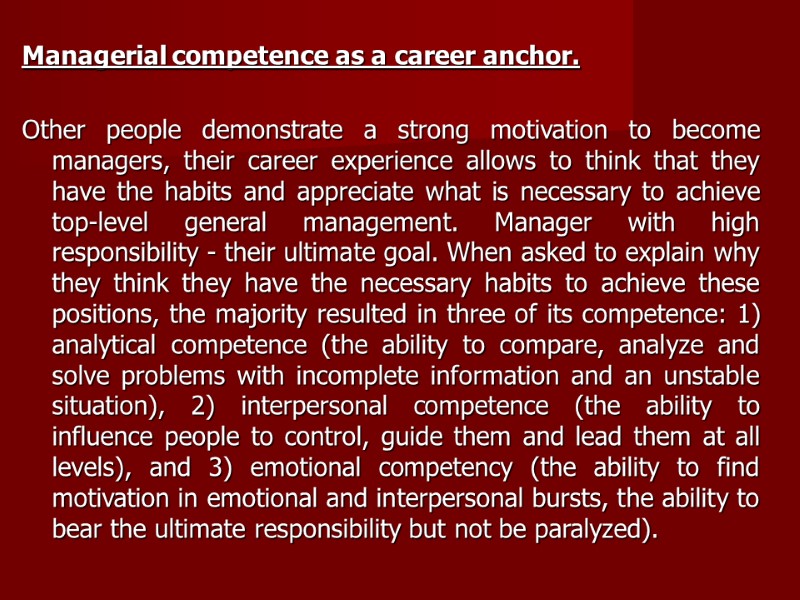
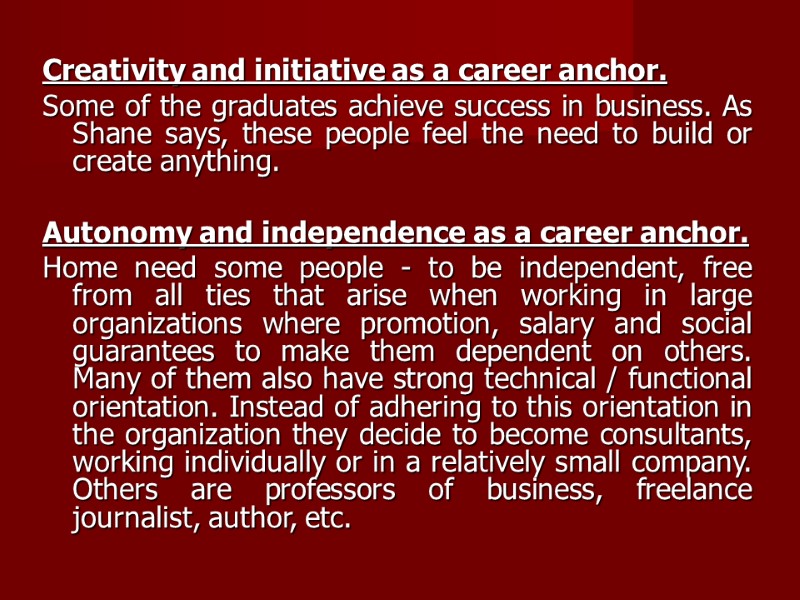
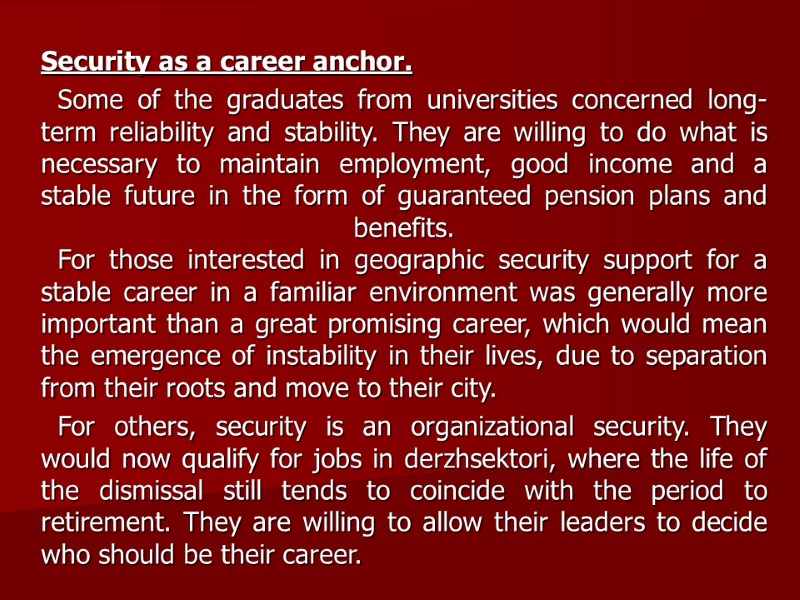
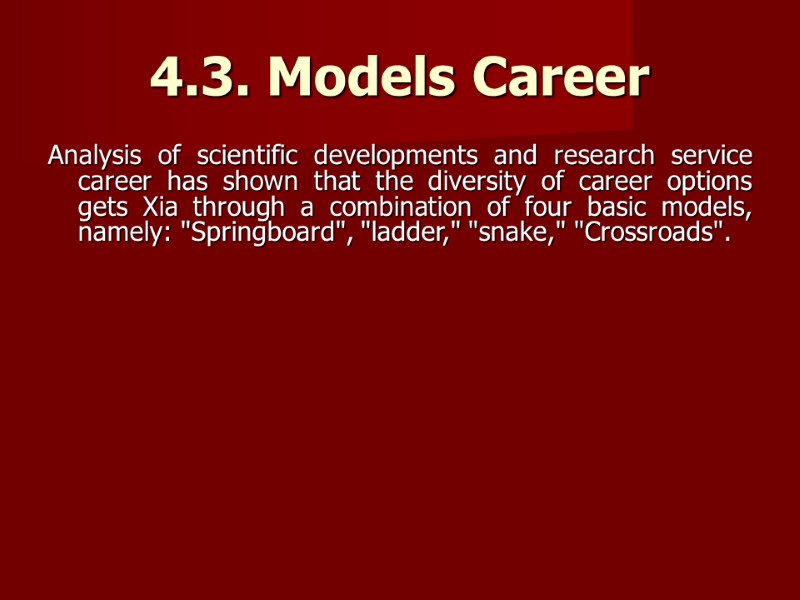

14282-topic_3.ppt
- Количество слайдов: 26
 THE MOVEMENT OF PERSONNEL
THE MOVEMENT OF PERSONNEL
 Contents 4.1. Career Management 4.2. The essence of service and professional promotion 4.3. Models Career
Contents 4.1. Career Management 4.2. The essence of service and professional promotion 4.3. Models Career
 4.1. Career Management Career is a sequence of staff job roles. This term should ideally also involve the promotion of the ladder up. However, events such as involuntary redundancy, short-term contracts, the part-time employment, the replacement of hierarchical organizational structures more "flat" sublime ideal notion of a career. Thus, not only moving up the corporate ladder can be regarded as career development, but also increased the content of the work, horizontal movement and freelance work. Business career - is the gradual movement of a person in a certain sphere of activity, abilities, qualifying opportunities and remuneration-related activities; progress on the path chosen activity to achieve recognition and success in society.
4.1. Career Management Career is a sequence of staff job roles. This term should ideally also involve the promotion of the ladder up. However, events such as involuntary redundancy, short-term contracts, the part-time employment, the replacement of hierarchical organizational structures more "flat" sublime ideal notion of a career. Thus, not only moving up the corporate ladder can be regarded as career development, but also increased the content of the work, horizontal movement and freelance work. Business career - is the gradual movement of a person in a certain sphere of activity, abilities, qualifying opportunities and remuneration-related activities; progress on the path chosen activity to achieve recognition and success in society.
 Broader definition of career is a "human development in learning and work throughout their lives". Thus the definition of a career can include both career and life experience. The main purpose of career development can be defined as "meeting current and future needs of the organization and the employee", which implies that the care of the career development of staff by managers, implemented in the form of planning, organizing career incentives to career growth, benefits of the organization. In theory, personnel management allocate such types of careers as: Exterorganizational career, which means that the employee during his career has passed all stages of development: training, recruitment, professional growth, individual development, retirement. In this case, we consider the promotion of employees within one organization. Such a career can be specialized and unspecialized. Interorganizational career, which means that a particular employee during of his career passes all stages of development consistently, within the boundaries of positions in different organizations.
Broader definition of career is a "human development in learning and work throughout their lives". Thus the definition of a career can include both career and life experience. The main purpose of career development can be defined as "meeting current and future needs of the organization and the employee", which implies that the care of the career development of staff by managers, implemented in the form of planning, organizing career incentives to career growth, benefits of the organization. In theory, personnel management allocate such types of careers as: Exterorganizational career, which means that the employee during his career has passed all stages of development: training, recruitment, professional growth, individual development, retirement. In this case, we consider the promotion of employees within one organization. Such a career can be specialized and unspecialized. Interorganizational career, which means that a particular employee during of his career passes all stages of development consistently, within the boundaries of positions in different organizations.
 Specialized career characterizes a profession and scope of the employee, and nonspecialized replacement worker occupies various posts within various activities. In addition, the distinguished career of the vertical (which is related to the promotion of an employee on the steps of the organizational hierarchy), horizontal (moving to another functional area within the boundaries of one level of the organizational hierarchy), centripetal (a combination of vertical and horizontal types of careers), hidden (targeted and rapid movement to the leadership of the organization). Personnel policy defines the basic principles of career development for a particular worker and approaches to career management review.
Specialized career characterizes a profession and scope of the employee, and nonspecialized replacement worker occupies various posts within various activities. In addition, the distinguished career of the vertical (which is related to the promotion of an employee on the steps of the organizational hierarchy), horizontal (moving to another functional area within the boundaries of one level of the organizational hierarchy), centripetal (a combination of vertical and horizontal types of careers), hidden (targeted and rapid movement to the leadership of the organization). Personnel policy defines the basic principles of career development for a particular worker and approaches to career management review.
 So, one should have developed job descriptions for the reliable description of the major functions, rights, duties and responsibilities of the employees. In relation to the new employee it is necessary to demonstrate confidence and friendly attitudes, along with insistence to the qualifications and professionalism. In order for an employee quickly join the stabilization phase, it is necessary to give him the opportunity to learn a different job, that is to ensure the principle of staff rotation. There are many recommendations on career management for development prospects of the organization. Thus, E. Mayo describes the structure of systems of career management. According to his point of view, a career management process is the epitome of organization and organizational processes by which individual staff career is planed and managed in such a way that it allows on the one hand, to satisfy the commercial interests of the organization, on the other fond to meet the abilities of individual employees. This definition could be formulated only after it has been recognized as "contractual" nature of any relationship that related to career.
So, one should have developed job descriptions for the reliable description of the major functions, rights, duties and responsibilities of the employees. In relation to the new employee it is necessary to demonstrate confidence and friendly attitudes, along with insistence to the qualifications and professionalism. In order for an employee quickly join the stabilization phase, it is necessary to give him the opportunity to learn a different job, that is to ensure the principle of staff rotation. There are many recommendations on career management for development prospects of the organization. Thus, E. Mayo describes the structure of systems of career management. According to his point of view, a career management process is the epitome of organization and organizational processes by which individual staff career is planed and managed in such a way that it allows on the one hand, to satisfy the commercial interests of the organization, on the other fond to meet the abilities of individual employees. This definition could be formulated only after it has been recognized as "contractual" nature of any relationship that related to career.
 E. Mayo describes the different systems of career management, and these systems are called: the processes of planning an individual's career, the processes of joint planning career, and organizational processes. Individual career planning processes include: professional consulting; team working on planning for career development; plans for employer self-development; identification of career resource centers.
E. Mayo describes the different systems of career management, and these systems are called: the processes of planning an individual's career, the processes of joint planning career, and organizational processes. Individual career planning processes include: professional consulting; team working on planning for career development; plans for employer self-development; identification of career resource centers.
 Organizational processes include: appointment process; system of career; succession planning, continuity of a career; advertising; planning for manpower needs; special fast-track promotion for prospective employees. The processes of joint planning career include: analysis of the estimates and level of development; assessment centers to evaluate personnel; development centers;
Organizational processes include: appointment process; system of career; succession planning, continuity of a career; advertising; planning for manpower needs; special fast-track promotion for prospective employees. The processes of joint planning career include: analysis of the estimates and level of development; assessment centers to evaluate personnel; development centers;
 The above-mentioned processes can meet the needs of both the organization and its employees. However, the success of these processes depends largely on the organizational culture. Ultimately, the real negotiations with the employees can only be held only in case when the entire management of the company shares with subordinates the original principles and values, and priorities.
The above-mentioned processes can meet the needs of both the organization and its employees. However, the success of these processes depends largely on the organizational culture. Ultimately, the real negotiations with the employees can only be held only in case when the entire management of the company shares with subordinates the original principles and values, and priorities.
 These principles and values should include the following: 1. The organization exists for the welfare of its employees in the same way in which employees do for the welfare of the organization. 2. If the employee improves competitiveness, it helps to strengthen the intellectual capacity of the organization, and due to this - the dominant position in relation to competitors. 3. Employees of the organization differ in their career prospects and expectations at different stages of development. 4. The most valuable employees of the organization over time, will attempt to go to work at another company, or work less than they can. 5. Changes, which are displayed on the labor market may lead to a change in the balance of different forces. 6. Negotiations on a career can be conducted only if the individual worker and a representative of the company's management can talk openly about what they want to achieve, and are able to compromise.
These principles and values should include the following: 1. The organization exists for the welfare of its employees in the same way in which employees do for the welfare of the organization. 2. If the employee improves competitiveness, it helps to strengthen the intellectual capacity of the organization, and due to this - the dominant position in relation to competitors. 3. Employees of the organization differ in their career prospects and expectations at different stages of development. 4. The most valuable employees of the organization over time, will attempt to go to work at another company, or work less than they can. 5. Changes, which are displayed on the labor market may lead to a change in the balance of different forces. 6. Negotiations on a career can be conducted only if the individual worker and a representative of the company's management can talk openly about what they want to achieve, and are able to compromise.
 One of the latest models of career guidance is aimed at helping employes to take control of their careers. Such management involves developing the ability to view their personal careers in a constantly changing context of the modern labor market, unstable social, political and organizational realities. This model requires the ability of employees to self-development, and it shows itself in such a way that they not only maintained at a certain level, but have improved their competitiveness.
One of the latest models of career guidance is aimed at helping employes to take control of their careers. Such management involves developing the ability to view their personal careers in a constantly changing context of the modern labor market, unstable social, political and organizational realities. This model requires the ability of employees to self-development, and it shows itself in such a way that they not only maintained at a certain level, but have improved their competitiveness.
 4.2. The essence of service and professional promotion Personnel Management in its broadest sense is based on the assumption that an enterprise (organization) commits itself the best use of labor potential employees and provide them with the opportunity to self-expression and self-actualization. It takes place in career planning and development of staff, that is to promote service and professional growth of employees.
4.2. The essence of service and professional promotion Personnel Management in its broadest sense is based on the assumption that an enterprise (organization) commits itself the best use of labor potential employees and provide them with the opportunity to self-expression and self-actualization. It takes place in career planning and development of staff, that is to promote service and professional growth of employees.
 There are three types of service and professional employees promotion: 1) Horizontal promotion is a promoting at the same level from one department of the organization. This kind of movement provides that an employee in a short time study the qualification requirements that they apply to the new workplace. Although this level of performance can be affected, but in the future, the worker receives a perspective in various areas; 2) Decrease (moving to the lower level) in the position; 3) Use of moving to the previous position - a relatively new method, which is associated with decreased risk of having a place in the horizontal move or slide. The practice is based on the fact that an employee who moves may return to the previous position if it does not like new.
There are three types of service and professional employees promotion: 1) Horizontal promotion is a promoting at the same level from one department of the organization. This kind of movement provides that an employee in a short time study the qualification requirements that they apply to the new workplace. Although this level of performance can be affected, but in the future, the worker receives a perspective in various areas; 2) Decrease (moving to the lower level) in the position; 3) Use of moving to the previous position - a relatively new method, which is associated with decreased risk of having a place in the horizontal move or slide. The practice is based on the fact that an employee who moves may return to the previous position if it does not like new.
 Regardless of differences in the nature, types, temperaments, abilities and habits, are usually distinguished general stage for the entire cycle of career growth. So, first comes the stage of growth - from birth to 14 years. At this time the formation of human personality through social influence. The next step is research, which covers the period from about 15 to 24 years, during which a person explores emerging professional alternative. Preliminary choice of profession and career is usually made this period.
Regardless of differences in the nature, types, temperaments, abilities and habits, are usually distinguished general stage for the entire cycle of career growth. So, first comes the stage of growth - from birth to 14 years. At this time the formation of human personality through social influence. The next step is research, which covers the period from about 15 to 24 years, during which a person explores emerging professional alternative. Preliminary choice of profession and career is usually made this period.
 The third stage - the formation. It lasts from 24 years to 44 years and is fundamental in human life, because at the present time, a person does the work, which helps him to take a permanent place in the professional direction favorites. This stage is divided into substage test (25-30 years). At this substage person decides whether he fits the profession, as there may be different perceptions of work in theoretical and practical aspects. It is believed that up to 30 years old person is more mobile and can change the scope of activities. Then at the age of 30-40 years a person goes through stabilization substage.
The third stage - the formation. It lasts from 24 years to 44 years and is fundamental in human life, because at the present time, a person does the work, which helps him to take a permanent place in the professional direction favorites. This stage is divided into substage test (25-30 years). At this substage person decides whether he fits the profession, as there may be different perceptions of work in theoretical and practical aspects. It is believed that up to 30 years old person is more mobile and can change the scope of activities. Then at the age of 30-40 years a person goes through stabilization substage.
 During this period, professional goals are clearly defined. Main attention is paid to career development, enhance activity in the direction of change and development work, self-education. Substage career crisis begins, on average between 45-55 years. At this substage person makes soul-searching, analyzing his work, success, progress, achievement of goals. This period is the most difficult, because the person usually does not reach all the scheduled early in his career, don't fully implement their dreams. Between 45 and 65 years people pass the stage of conservation. At this time, employees have already reached quite a lot in professional activities, has found his niche in the world and therefore it remains only to preserve achieved. The last stage - the stage of decrease in activity occurs at retirement, which is associated with the need to accept the limitation of power, activity and responsibility.
During this period, professional goals are clearly defined. Main attention is paid to career development, enhance activity in the direction of change and development work, self-education. Substage career crisis begins, on average between 45-55 years. At this substage person makes soul-searching, analyzing his work, success, progress, achievement of goals. This period is the most difficult, because the person usually does not reach all the scheduled early in his career, don't fully implement their dreams. Between 45 and 65 years people pass the stage of conservation. At this time, employees have already reached quite a lot in professional activities, has found his niche in the world and therefore it remains only to preserve achieved. The last stage - the stage of decrease in activity occurs at retirement, which is associated with the need to accept the limitation of power, activity and responsibility.
 Consultant staff, John Holland says, that the individuality of personality (values, motivations and needs) are an important factor in career choice. He determines that there are six basic personality orientations that define the types of careers to which people are most suitable. For example, a person with a strong social orientation might be attracted to a career in the field, which is associated with the interpersonal, rather than intellectual or physical activity, or social work. Based on a study using the developed of Vocational Test, Holland identified six basic individual orientations.
Consultant staff, John Holland says, that the individuality of personality (values, motivations and needs) are an important factor in career choice. He determines that there are six basic personality orientations that define the types of careers to which people are most suitable. For example, a person with a strong social orientation might be attracted to a career in the field, which is associated with the interpersonal, rather than intellectual or physical activity, or social work. Based on a study using the developed of Vocational Test, Holland identified six basic individual orientations.
 Six basic personality orientations that define the types of careers: 1. Realistic orientation. People who hold this orientation, tend to be those related to physical strength, which requires habits, strength and coordination. For example, forestry, farming and agriculture. 2. Research orientation. These people tend to be career-related rather to introverted activities (philosophy, organization, interpretation) than the affective (feelings, emotions and interpersonal communication). For example, biologists, chemists, college professor. 3. Artistic orientation. Here, people are inclined to a career that demands self-expression, artistic creativity, emotional expression and personality. Examples are artists, musicians, creators of advertising.
Six basic personality orientations that define the types of careers: 1. Realistic orientation. People who hold this orientation, tend to be those related to physical strength, which requires habits, strength and coordination. For example, forestry, farming and agriculture. 2. Research orientation. These people tend to be career-related rather to introverted activities (philosophy, organization, interpretation) than the affective (feelings, emotions and interpersonal communication). For example, biologists, chemists, college professor. 3. Artistic orientation. Here, people are inclined to a career that demands self-expression, artistic creativity, emotional expression and personality. Examples are artists, musicians, creators of advertising.
 4. Social orientation. These people are prone to a career that has in mind the interpersonal rather than intellectual or physical interaction. Diplomatic service, social work. 5. Action Orientation. These people are inclined to a career that is related to the verbal activity, the impact on others: managers, lawyers, press secretary. 6. Ordinary orientation. These people prefer a career that provides a structured, regulated activities and professions in which the employee should compare his personal needs with the organizational (accountants and bankers).
4. Social orientation. These people are prone to a career that has in mind the interpersonal rather than intellectual or physical interaction. Diplomatic service, social work. 5. Action Orientation. These people are inclined to a career that is related to the verbal activity, the impact on others: managers, lawyers, press secretary. 6. Ordinary orientation. These people prefer a career that provides a structured, regulated activities and professions in which the employee should compare his personal needs with the organizational (accountants and bankers).
 Most people have more than one orientation, and the Holland believes that the more similar or compatible with the orientation, the lower the level of internal conflict, the easier to decide on career choices. Edgar Schein points out that career planning is a process of slow development of professional self-conception and self-determination in terms of their own abilities, talents, motivations, needs, attitudes and values . Shane also argues that people form a defining point in his career or as they say, a career anchor - the interest or value - from which a person would not give up if you want to make a choice. Career key points - this phase points curving line career, around which the oscillations occur person's career, a person is aware of their existence as a result of the assessments of their abilities and talents, motives and needs, attitudes and values. Shane believes that the key moments of a career is difficult to predict in advance, as they are the product of evolution and the process of discovery. Some people can not impose its key points of a career, until faced with the need to make a major choice. For example, take a seat in business management or discontinue its business in the beginning.
Most people have more than one orientation, and the Holland believes that the more similar or compatible with the orientation, the lower the level of internal conflict, the easier to decide on career choices. Edgar Schein points out that career planning is a process of slow development of professional self-conception and self-determination in terms of their own abilities, talents, motivations, needs, attitudes and values . Shane also argues that people form a defining point in his career or as they say, a career anchor - the interest or value - from which a person would not give up if you want to make a choice. Career key points - this phase points curving line career, around which the oscillations occur person's career, a person is aware of their existence as a result of the assessments of their abilities and talents, motives and needs, attitudes and values. Shane believes that the key moments of a career is difficult to predict in advance, as they are the product of evolution and the process of discovery. Some people can not impose its key points of a career, until faced with the need to make a major choice. For example, take a seat in business management or discontinue its business in the beginning.
 It was at a key moment of the career experience of the last man, his interests, taking care of family, ability and attitude show that the most important for him at the moment. Based on the research of specialists at the Massachusetts Institute of Technology (MTI), Shane identified five career moments. Technical / functional career anchor. People who have strong technical / functional career anchor, try to avoid decisions that lead them to work in the field of general management. They are able to make decisions that allow them to stay and grow in selected technical or functional areas.
It was at a key moment of the career experience of the last man, his interests, taking care of family, ability and attitude show that the most important for him at the moment. Based on the research of specialists at the Massachusetts Institute of Technology (MTI), Shane identified five career moments. Technical / functional career anchor. People who have strong technical / functional career anchor, try to avoid decisions that lead them to work in the field of general management. They are able to make decisions that allow them to stay and grow in selected technical or functional areas.
 Managerial competence as a career anchor. Other people demonstrate a strong motivation to become managers, their career experience allows to think that they have the habits and appreciate what is necessary to achieve top-level general management. Manager with high responsibility - their ultimate goal. When asked to explain why they think they have the necessary habits to achieve these positions, the majority resulted in three of its competence: 1) analytical competence (the ability to compare, analyze and solve problems with incomplete information and an unstable situation), 2) interpersonal competence (the ability to influence people to control, guide them and lead them at all levels), and 3) emotional competency (the ability to find motivation in emotional and interpersonal bursts, the ability to bear the ultimate responsibility but not be paralyzed).
Managerial competence as a career anchor. Other people demonstrate a strong motivation to become managers, their career experience allows to think that they have the habits and appreciate what is necessary to achieve top-level general management. Manager with high responsibility - their ultimate goal. When asked to explain why they think they have the necessary habits to achieve these positions, the majority resulted in three of its competence: 1) analytical competence (the ability to compare, analyze and solve problems with incomplete information and an unstable situation), 2) interpersonal competence (the ability to influence people to control, guide them and lead them at all levels), and 3) emotional competency (the ability to find motivation in emotional and interpersonal bursts, the ability to bear the ultimate responsibility but not be paralyzed).
 Creativity and initiative as a career anchor. Some of the graduates achieve success in business. As Shane says, these people feel the need to build or create anything. Autonomy and independence as a career anchor. Home need some people - to be independent, free from all ties that arise when working in large organizations where promotion, salary and social guarantees to make them dependent on others. Many of them also have strong technical / functional orientation. Instead of adhering to this orientation in the organization they decide to become consultants, working individually or in a relatively small company. Others are professors of business, freelance journalist, author, etc.
Creativity and initiative as a career anchor. Some of the graduates achieve success in business. As Shane says, these people feel the need to build or create anything. Autonomy and independence as a career anchor. Home need some people - to be independent, free from all ties that arise when working in large organizations where promotion, salary and social guarantees to make them dependent on others. Many of them also have strong technical / functional orientation. Instead of adhering to this orientation in the organization they decide to become consultants, working individually or in a relatively small company. Others are professors of business, freelance journalist, author, etc.
 Security as a career anchor. Some of the graduates from universities concerned long-term reliability and stability. They are willing to do what is necessary to maintain employment, good income and a stable future in the form of guaranteed pension plans and benefits. For those interested in geographic security support for a stable career in a familiar environment was generally more important than a great promising career, which would mean the emergence of instability in their lives, due to separation from their roots and move to their city. For others, security is an organizational security. They would now qualify for jobs in derzhsektorі, where the life of the dismissal still tends to coincide with the period to retirement. They are willing to allow their leaders to decide who should be their career.
Security as a career anchor. Some of the graduates from universities concerned long-term reliability and stability. They are willing to do what is necessary to maintain employment, good income and a stable future in the form of guaranteed pension plans and benefits. For those interested in geographic security support for a stable career in a familiar environment was generally more important than a great promising career, which would mean the emergence of instability in their lives, due to separation from their roots and move to their city. For others, security is an organizational security. They would now qualify for jobs in derzhsektorі, where the life of the dismissal still tends to coincide with the period to retirement. They are willing to allow their leaders to decide who should be their career.
 4.3. Models Career Analysis of scientific developments and research service career has shown that the diversity of career options gets Xia through a combination of four basic models, namely: "Springboard", "ladder," "snake," "Crossroads".
4.3. Models Career Analysis of scientific developments and research service career has shown that the diversity of career options gets Xia through a combination of four basic models, namely: "Springboard", "ladder," "snake," "Crossroads".


